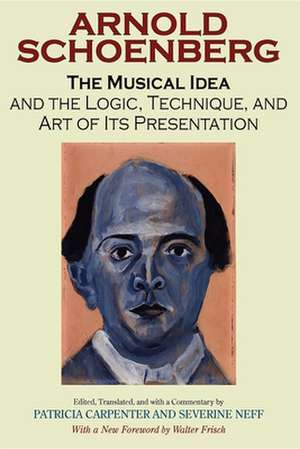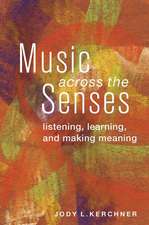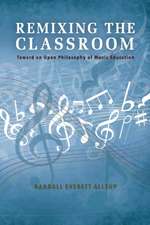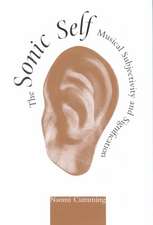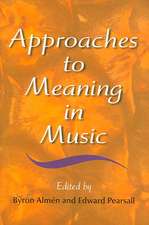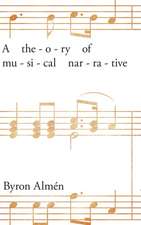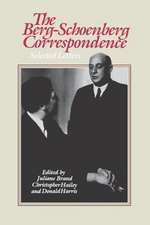The Musical Idea and the Logic, Technique, and Art of Its Presentation, New Paperback English Edition
Autor Arnold Schoenberg, Severine Neffen Limba Engleză Paperback – 17 iul 2006
Preț: 229.32 lei
Nou
Puncte Express: 344
Preț estimativ în valută:
43.89€ • 47.65$ • 36.86£
43.89€ • 47.65$ • 36.86£
Carte tipărită la comandă
Livrare economică 22 aprilie-06 mai
Preluare comenzi: 021 569.72.76
Specificații
ISBN-13: 9780253218353
ISBN-10: 0253218357
Pagini: 376
Ilustrații: 1
Dimensiuni: 163 x 230 x 20 mm
Greutate: 0.54 kg
Editura: MH – Indiana University Press
Locul publicării:United States
ISBN-10: 0253218357
Pagini: 376
Ilustrații: 1
Dimensiuni: 163 x 230 x 20 mm
Greutate: 0.54 kg
Editura: MH – Indiana University Press
Locul publicării:United States
Notă biografică
Arnold Schoenberg (1874¿1951) is one of the most prominent figures in 20th-century music and musical thought, perhaps best known for his development of Twelve Tone theory.
Patricia Carpenter (1923¿2000) was Professor Emerita, Barnard College, and former Vice President of the Society for Music Theory.
Severine Neff is currently Eugene Falk Distinguished Professor in the Department of Music at the University of North Carolina, Chapel Hill.
Cuprins
Contents
Foreword (2006) by Walter Frisch
List of Abbreviations of Cited Sources
Editors' Preface
Acknowledgments
Commentary
Schoenberg's View of Art
Schoenberg's Preface
The Musical Idea
Comprehensibility and Coherence
Theory of Form
The Constructive Function of Harmony
Conclusion
The Musical Idea and the Logic, Technique, and Art of Its Presentation
Preface and Overview
Preface
Title Page
Principles of the Presentation of the Idea
Plan of the Book
The Profundity of the Idea and Its Realization as a Standard
The Musical Idea and the Logic, Technique, and Art of Its Presentation
Idea (1 and 2)
The Idea in the Contrapuntal Art of Composition and Its Presentation
Principles of Construction
Comprehensibility
Laws of Comprehensibility
Coherence
The Laws of Musical Coherence
Elements of Form
The Parts of a Piece
Part
Elements of Form
Phrase
Gestalt
Grundgestalt and Motive
The Difference Between Gestalt and Phrase
Features of the Motive
Statement
Stable Formation
Loose Formation
Theme
Melody
Sonority as a Formative Element
Rhythm
Rhythm
Classification of Rhythms
Accentuation and Nonaccentuation
Formal Procedures
[Formal Procedures]
Articulation
Change, Variation, Variant, Varying
Kinds of Variation
Coherence of "New Components"
Mirror Forms
Close
Cadencing
Cadential Fall
Kinds of Connection
Technique of Joining
Condensation
Dissolution, Liquidation
Tendency of the Smallest Notes
The Structural Capacities of the Scale
Wave-Shaped Progression
Contrasts (Contrasting Themes)
Digression from the Main Idea
Principal Idea, Subsidiary Idea
Subordinate Theme
Secondary, Tertiary, etc. Gestalten and Motives
The Shaping of Principal and Subordinate (Accompanying) Voices
Development Section
Sequences
Intensification
Does Repetition Have an Intensifying Effect?
Voice (Independent)
Introduction (1 and 2)
Preparation
Extramusical Means of Coherence
Fantasy
Description of All Forms
Miscellaneous
Performance and Gestalt
The Sense of Rit. and Accel.
Relaxation
Symmetry
Origin of Repetitions
Primitive Principles
Popular Music and Melody
Harmony
The Constructive Function of Harmony
Addendum
Keywords Still to Be Indexed
Keywords
Concordance of Terms
Appendix 1 Descriptions of the Gedanke Manuscripts
Appendix 2 Contents of Manuscript No. 10, Listed in Their Original Order
Appendix 3 German Texts of Unpublished Gedanke Manuscripts Referred to in the Commentary
Notes
Bibliography
Index of Musical Examples
Name Index
Subject Index
Foreword (2006) by Walter Frisch
List of Abbreviations of Cited Sources
Editors' Preface
Acknowledgments
Commentary
Schoenberg's View of Art
Schoenberg's Preface
The Musical Idea
Comprehensibility and Coherence
Theory of Form
The Constructive Function of Harmony
Conclusion
The Musical Idea and the Logic, Technique, and Art of Its Presentation
Preface and Overview
Preface
Title Page
Principles of the Presentation of the Idea
Plan of the Book
The Profundity of the Idea and Its Realization as a Standard
The Musical Idea and the Logic, Technique, and Art of Its Presentation
Idea (1 and 2)
The Idea in the Contrapuntal Art of Composition and Its Presentation
Principles of Construction
Comprehensibility
Laws of Comprehensibility
Coherence
The Laws of Musical Coherence
Elements of Form
The Parts of a Piece
Part
Elements of Form
Phrase
Gestalt
Grundgestalt and Motive
The Difference Between Gestalt and Phrase
Features of the Motive
Statement
Stable Formation
Loose Formation
Theme
Melody
Sonority as a Formative Element
Rhythm
Rhythm
Classification of Rhythms
Accentuation and Nonaccentuation
Formal Procedures
[Formal Procedures]
Articulation
Change, Variation, Variant, Varying
Kinds of Variation
Coherence of "New Components"
Mirror Forms
Close
Cadencing
Cadential Fall
Kinds of Connection
Technique of Joining
Condensation
Dissolution, Liquidation
Tendency of the Smallest Notes
The Structural Capacities of the Scale
Wave-Shaped Progression
Contrasts (Contrasting Themes)
Digression from the Main Idea
Principal Idea, Subsidiary Idea
Subordinate Theme
Secondary, Tertiary, etc. Gestalten and Motives
The Shaping of Principal and Subordinate (Accompanying) Voices
Development Section
Sequences
Intensification
Does Repetition Have an Intensifying Effect?
Voice (Independent)
Introduction (1 and 2)
Preparation
Extramusical Means of Coherence
Fantasy
Description of All Forms
Miscellaneous
Performance and Gestalt
The Sense of Rit. and Accel.
Relaxation
Symmetry
Origin of Repetitions
Primitive Principles
Popular Music and Melody
Harmony
The Constructive Function of Harmony
Addendum
Keywords Still to Be Indexed
Keywords
Concordance of Terms
Appendix 1 Descriptions of the Gedanke Manuscripts
Appendix 2 Contents of Manuscript No. 10, Listed in Their Original Order
Appendix 3 German Texts of Unpublished Gedanke Manuscripts Referred to in the Commentary
Notes
Bibliography
Index of Musical Examples
Name Index
Subject Index
